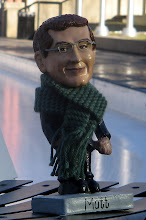For example, I wrote that "there's a continuous need to get the elbow onto or above the plane of the string - our elbows tend to dangle down below," as though that were a rule: dangly elbow = bad bass playing. There's also a case to be made for keeping the elbow lower, though:
The lower the upper arm, that is, the lower the elbow, the less energy is necessary to hold it. At the same time there is an increase in the energy that the biceps must provide to maintain the angle at the elbow. Since the forearm weighs less than the entire arm, less energy is necessary at a low-elbow position than at a high one.Less energy means more efficient, which means better playing, right? Well, not necessarily. Mantel suggests an experiment using a letter scale:
- Gerhard Mantel, Cello Technique: Principles and Forms of Movement, p. 170-1
Take up the bow and put the tip on the scale. Now press on the scale as hard as possible, once with a low elbow, once with a high elbow. With the elbow low the scale will register about half what it will with the elbow high. Thus we can deduce:Mantel's experiment doesn't account for many of the factors in bow position, but it does lead to a basic understanding of the physics involved. For louder dynamics, and particularly for playing loudly at the tip, a higher elbow will tend to be more powerful; at softer dynamics, and when playing towards the frog, a lower elbow will tend to be more efficient. I recorded a video of myself playing an excerpt from Mendelssohn 3 to try and gauge where the right elbow goes:
An increase in dynamics requires an appropriately higher elbow position.
- p. 171
And there are certainly moments when it goes "submarine", and others when it lifts. Not that my playing is the authoritative example of right elbow usage! What I especially wanted to stress in my original post was to not settle for one answer; observe lots of bass players, and other string players as well. The basic principles of shoulder, elbow and hand movement are surprisingly similar across all the string instruments, and even for German bow players.
Mantel adds another point that I wanted to stress in my post:
One final warning: So far we have assumed that the shoulder is a pivot point that is steady, whereas in fact it can make rather big circular movements. It can be pushed forward, up, and back. If the shoulder is habitually raised, unnecessary muscle activity will result, which may hinder the control of small motor impulses in the entire right arm. A raised shoulder is also a visual expression of insecurity and should be avoided.So while there may be no rule on lifting the elbow, there's an essential one on lifting the shoulder: don't do it! I have to continuously watch out for that in my own playing, and it sounds as though Stan does as well - he emphasizes keeping the shoulder in a relaxed position.
- p. 172


 Technorati Link Count: no. of blog reactions to this post
Technorati Link Count: no. of blog reactions to this post
3 comments:
You've gotta love the Scottish - well played, Matt.
Thanks Matt. Allison and I just watched this video and read your post in trying to figure out why my wrist isn't moving (as we discussed in the lesson). The video helped me (and my disciplinarian Al).
Rob
I love this info right here!
Elbow Stretches
Post a Comment